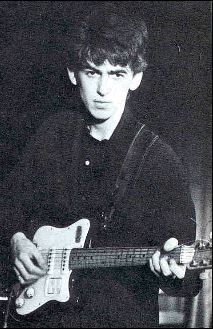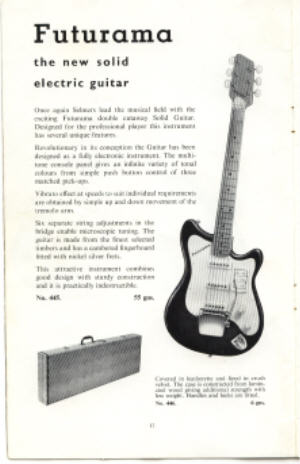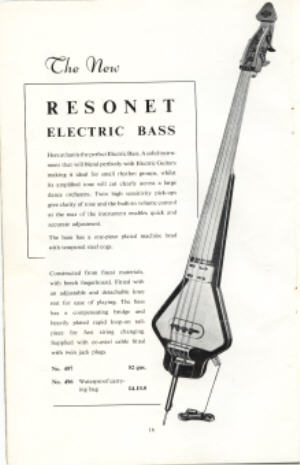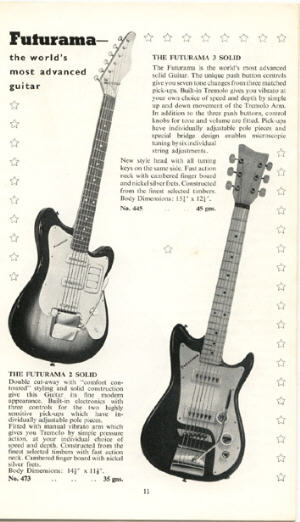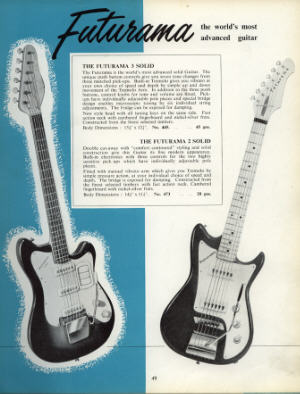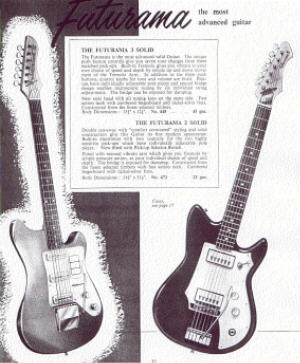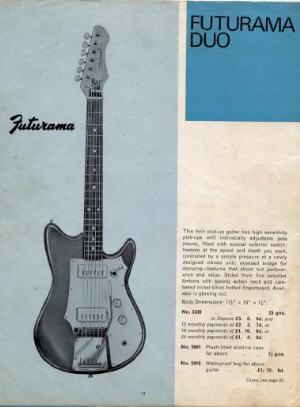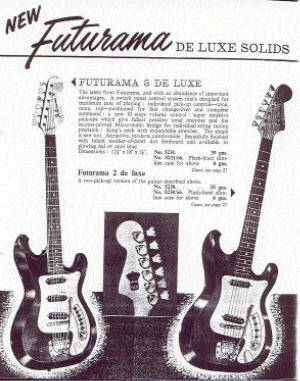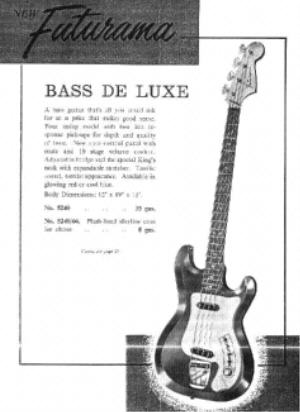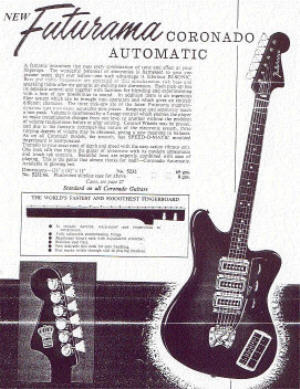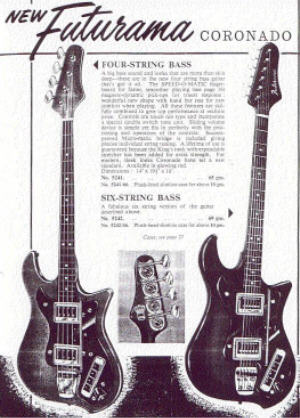- 12 гитар Джорджа Харрисона
- THE FUTURAMA GUITAR STORY
- THE WORLD’S MOST ADVANCED GUITAR?
- FOR EXAMPLES OF FUTURAMA GUITARS, VISIT THE FUTURAMA VISITORS’ GALLERY
- THE STORY SO FAR:
- 1. THE DREVOKOV RESONET GUITARS
- 2. THE C.S.H.N. NEOTON/JOLANA GUITARS
- 3. THE C.S.H.N. JOLANA GUITARS — 2nd SERIES
- 4. THE HAGSTROM-MADE FUTURAMA DELUXE
- Around May 1963, Selmer introduced the (almost) all new Futurama range. (Almost, because the old Futurama II continued in the catalogue until 1965 under the name of the «Futurama Duo».) These very presentable new guitars were manufactured by Hagstrom in Sweden and were fitted with something called a «King’s Neck», which apparently had an «expandable stretcher»; presumably a fancy truss rod.(?)
- A three pickup Futurama 3 De Luxe and two pickup Futurama 2 De Luxe were offered in «glowing red» or «cool blue». The previous winning formula of lots of switches and a (Hagstrom design) tremolo were maintained on these guitars, and a matching Bass De Luxe rounded off the range.
- In fact, Hagstrom had been producing an export-only line for some time prior to these guitars being adopted and given the Futurama name by Selmer. They combined elements of the Hagstrom Kent and Hagstrom II/III models.
- 5. THE HAGSTROM-MADE FUTURAMA CORONADO
12 гитар Джорджа Харрисона
Рассказ о гитарах известного музыканта, участника группы Beatles Джорджа Харрисона
Сегодня, в день, когда легендарному Джорджу Харрисону исполнилось бы 72 года, Fishki хотят познакомить вас с гитарами, на которых он играл.
Gretsch Duo Jet
Первая гитара Джорджа Харрисона. Она была куплена в 1957 году и активно использовалась во время записи первых альбомов Beatles. По легенде, эту гитару Джорджу продал некто Айван Хейворд, который в интервью USA Today заявил: «Она была совсем легкой, ее можно было взять под мышку и идти куда угодно. Знаете, тогда это было то же самое, что заниматься любовью».
Кроме того, известно, что при покупке Харрисон оставил Хейворду долговую расписку, так как купил гитару за цену ниже заявленной.
Gibson SG Standard Electric Guitar
На этой гитаре Джордж Харрисон играет в видеоклипе на песню «Lady Madonna». Активно используя гитару в период с 1966 по 1968 год, Джордж впоследствии подарит ее своему другу – Эрику Клэптону.
Согласно информации с официального сайта Gibson, на этой гитаре Джордж играл в альбомах Rubber Soul и Revolver, а Джон Леннон – во время записи The White Album.
Эта гитара была продана с аукциона в 2004 году за $570 тысяч.
Futurama Guitar
Гитара, на которой юный Джордж играл во время выступлений группы в Гамбурге.
1962 Gibson J-160E
Акустическая гитара, на которой Джордж и Джон играли, пока Харрисон не приобрел модель Gibson J200. Произойдет это в конце шестидесятых годов.
Gibson SJ 200 Acoustic Guitar
На фото – Джордж Харрисон во время исполнения акустической версии песни «While My Guitar Gently Weeps» в 1968 году.
1968 Fender Rosewood Telecaster
Эту гитару Джордж активно использовал во время работы над альбомами «Abbey Road» и «Let it Be».
Gretsch Country Gentleman
На этой гитаре Джордж Харрисон играл в шоу Эда Салливана.
1957 Gibson Les Paul Standard
Эту гитару по прозвищу «Lucy» Джорджу подарил Эрик Клэптон в 1968 году. Изначально это был Les Paul GoldTop 1957 года, который перекрасили в вишневый цвет. Эрик купил этот Les Paul в Нью-Йорке в 60-х годах, когда был там с группой Cream.
Известно, что Харрисон достаточно много играл на этой гитаре в последние пару лет существования Beatles, когда были созданы альбомы «White Album», «Let It Be» и «Abbey Road». Ну а самой знаменитой песней, в которой можно услышать этот инструмент, является «While My Guitar Gently Weeps», где на ней сыграл Клэптон.
Rickenbacker 360 12-String Electric Guitar
Этот инструмент можно услышать в песне »A Hard Day’s Night» – Джордж сыграл на нем аккорды во вступлении.
1963 Gretsch 6119 Tennessean
Данную гитару можно услышать в песнях «Help!» и «A Hard Day’s Night». Кроме того, она активно использовалась на концертах группы в 1964-65 годах.
Epiphone Casino
Джордж Харрисон и его Epiphone. Последний публичный концерт группы Beatles, проходивший в Candlestick Park. Сан Франциско, Калифорния.
Fender Rocky Stratocaster
Инструмент, который Харрисон использовал как слайд-гитару во время своих соло.
С днем рождения, Джордж!
Понравилась статья? Подпишитесь на канал, чтобы быть в курсе самых интересных материалов
Источник
THE FUTURAMA GUITAR STORY
THE WORLD’S MOST ADVANCED GUITAR?
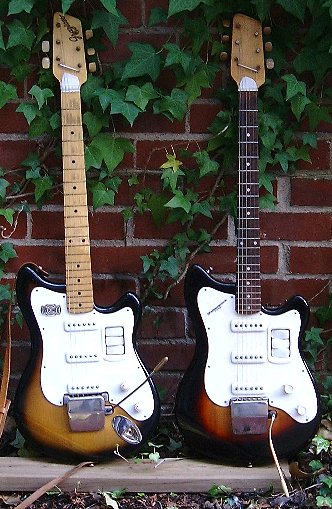
Resonet Grazioso and Futurama III courtesy of Dusan Palka, California, USA.
No, Futurama guitars were not made by Hofner. They were not even made in Germany. So why a page about them on a Hofner based website? Well. they were brought into the UK by Selmer as an alternative to their Hofner range in the late 1950’s and 1960’s, they were attractive, reasonable quality instruments by the standards of the day, they were priced at a level which could be afforded by UK guitarists, and. the Futurama III/Grazioso was arguably the most used individual solid electric guitar in use by the UK’s rock bands during those early days before Messrs Fender and Gibson’s products appeared in Britain! The Futurama brand name, (because that is what it was — a suitably eye-catching name given to imported instruments by Selmer), was therefore a major feature in early British rock music history.
George Harrison used a Futurama/Grazioso in the Beatles early Hamburg days; but so did everybody else. Take a look at the Gerry Marsden pictures in the Famous Selmer Users section of this website, and you will see a slightly later version of George’s guitar called the Futurama III. While you are there, take a look at what Tom McGuinness (later of Manfred Mann) is playing in the Eric Clapton picture. Jimmy Page changed his Hofner Senator for a Grazioso when his musical abilities were improving. And it was not just the (future) guitar legends — almost every band in the country had a Futurama III in it’s line-up during the very early 60’s.
The Futurama story is even more shrouded in the mists of time than that of Selmer amplification. As soon as the Brits got hold of their Stratocasters, the Futurama was instantly forgotten; destined to languish in junk shops, car-boot sales, and to act as knock-abouts for beginners to the guitar game for the next three or four decades. However, with the growing enthusiasm for all-things Beatle, particularly in the US, a little more interest is now being taken in these old workhorses. Having said that, there is still a long way to go before the Futurama is as sought after as a 1963 500/1 Violin Bass! Maybe this webpage will help just a little!
FOR EXAMPLES OF FUTURAMA GUITARS, VISIT THE FUTURAMA VISITORS’ GALLERY
THE STORY SO FAR:
In very brief, and maybe not totally reliable, terms the story goes something like this:
Pages from Selmer 1959 Catalogue.
1. THE DREVOKOV RESONET GUITARS
In 1958/59, Selmer commenced the import of a three pickup solid guitar which was manufactured initially at Blatn in Czechoslovakia under the Trade name of Resonet by the huge Drevokov Co-operative, part of which made furniture and. electric guitars!!) This guitar had the model name of «Grazioso» and was designed by a Mr Ruzicka who appears to have been the driving force behind all the Resonet guitars. (By the way, Resonet apparently means music played in a graceful, smooth, manner in Czechoslovakian.) No marketing man in the 50’s could have lived with product titles like that for very long, so after a short period Selmer changed the name in their catalogue to Futurama. This guitar was the nearest thing to the Stratocaster that was available at that time in Europe, but at 55 guineas was just about affordable to the British. I don’t suppose that it should come as any surprise that the Czechs actually gained their inspiration from a genuine Strat that they had imported from the States in 1955!
This very early version, called simply «Futurama» is the model that George Harrison used. It is characterised by the natural finished maple or sometimes beech (some later ones did in fact have rosewood) fingerboard, and the top-mounted jackplug socket. A double sided headstock is fitted with three-on-a-plate tuners, and the white scratchplate covers the majority of the body top. Body material was either beech or maple.
It seems that the earliest models available in the UK had Grazioso on the headstock and Resonet on the upper bout section of the white scratchplate. (George Harrison’s guitar had Resonet on the scratchplate, but not Grazioso on the headstock.)
But perhaps it was the electrics that resulted in the Futurama being given the title «The Worlds Most Advanced Electric Guitar» in future Selmer catalogues! Three pickups with individual «piano» type toggle switches for every conceivable combination of pickup selections (7No.). Now that certainly was more advanced than the Fender, which only had three combinations in those days! And the tremolo mechanism was pretty sophisticated too. Nothing else in the World, bar the Strat’s own trem unit could come near it for engineering excellence, with its individual bridge saddle adjustment and rear mounted springs acting on each string!
Resonet had been producing the Grazioso since late 1955, and as well as the sunburst guitars exported to the UK, several other finishes were available in Czechoslovakia, including red and black. Even an original purple Grazioso has been spotted in Ostrava!
During this period, Drevokov also supplied Selmer with the Resonet Electric Bass. This was a futuristic stand-up solid bass which proved quite popular due to the improved portability and sound volume of this compared to the traditional acoustic bass that was the norm up to the bass guitars becoming available in the UK.
1959/1960 Futurama III
Page from Selmer 1960/61 Catalogue
Page from Selmer 1961/62 Catalogue
2. THE C.S.H.N. NEOTON/JOLANA GUITARS
In 1959, the original Futurama Solid Guitar was replaced by a similar looking instrument that Selmer called the Futurama III, which had a rosewood look-a-like fingerboard (generally a dark stained beech) and a body-edge mounted jackplug socket. The tremolo unit also changed from a two post system to a separate wood mounted bridge unit. The change to a dark fingerboard was the most visible change however. Now, wasn’t it at about that time that Fender went onto rosewood boards?
The Futurama III guitar was actually made by a different company in Czechoslovakia called CSHN (or Czechoslovak Music Instruments in English) at Hradec Kralove . Production of this version commenced at Hradec in c1959 as the Grazioso production came to a halt at Resonet/Drevotvar in Blatna due to a change in management and the subsequent move of the afore mentioned Mr Ruzicka, the instigator of the Grazioso, Mr Josef Rika (the Drevotvar production manager) and Mr Vlek (the Drevotvar design engineer) to CSHN in Hradec.
The Hradec Kralove manufactured Futurama III was initially called the «Neoton Star II» (or perhaps Star III) initially in Czechoslovakia. The «Neoton» trade name was soon dropped however, being replaced by the trade name of «Jolana» — probably after the name of Mr Ruzickas’s daughter !!
A second twin pickup model was also introduced into the UK by Selmer at this stage called, naturally enough, the Futurama II. This guitar had just been developed by the new team at CSHN, and in Czechoslovakia was called the «Jolana Star I». The Futurama II, selling at 25 guineas as compared to the III’s 45 guineas, was very much the underdog, with a relatively unsophisticated tremolo and simple rotary controls for the electrics. It did have a light coloured «maple» (or maybe beech?) fingerboard however; perhaps the factory were using up old stocks of timber following the III’s up-grading to «rosewood».
The Futurama II seems to have been finished in various sombre solid colours only; the more expensive sunburst was not available on this budget model. I have seen mauve and black finishes on Futurama IIs.
A further change to the Futurama III occurred around late 1960, when the headstock was finally changed to single-sided, fitted with six individual open machine heads. The body finish generally remained as sunburst, but I have had a report of a red finish Futurama III of this type being purchased new in early 1962, so perhaps two of the Czech finishes were made available in the UK, or the red models were a transition towards the third version described below, which I believe appeared in 1963. Talking of headstocks, these would appear to have been produced to the same shape as on the Telecaster, and not as shown in the Selmer catalogue. Maybe the catalogue guitar was a prototype, or perhaps Selmer simple got an artist to alter an illustration of one of the previous 3-a-side headstock guitars. Certainly, picture «doctoring» was used on some of the Hofner guitar pictures in the catalogue.
The II’s headstock also went single-sided, but the light coloured «maple» fingerboard was retained for a little longer, before finally reverting to «rosewood» in 1963 when the whole guitar got a re-vamp (see below). The original large chrome capped control knobs on the II seemed to have decreased in diameter around about 1961.
Page from Selmer 1963 Catalogue
Page from Selmer 1965 Catalogue
3. THE C.S.H.N. JOLANA GUITARS — 2nd SERIES
The first big upset in the Futurama success story occurred in 1962. The Futurama IIIs appearing in the catalogues and shops at this time, at first glance seemed to be the same apart from a change in finish from sunburst to red/orange, but closer inspection revealed that something else had radically changed. The scratchplate had been reduced in size, and the plastic did not seem to be the same as the original sunburst versions. The headstock had suddenly become pointed in shape. The pickups had now taken on a cheap appearance with chromed plates, probably to facilitate adjustable pole pieces. The body did not have the same feel about it, particularly with the «comfort-contouring» now very apparent. What was going on?
Apparently SHN had commenced production of another version of the Star solid guitar from 1963 onwards; the Star V. This guitar was fitted with «Brilliant Deluxe» pickups. However, the guitar felt and played differently to the old sunburst jobs that we Brits had grown to know and love! OK, what with Hank and his red Strat, every solid sold in the country had to be red, and the guitar was still sold with the lovely light grey crocodile skin Selmer cases (at extra cost of course). But the change of the Futurama III/StarIII to Futurama III/Star V was more than skin-deep.
Al though rosewood fingerboards were normally fitted to the Futurama III of this era, I have heard of at least one that has a natural maple- looking board.
Oh! The Futurama II got a bright red finish also, together with a new rotary pickup selector close to the lower cutaway. This was fitted with a funny little handle presumably to aid speed of use. The previous very crude tremolo unit was replaced with something which looked slightly more sophisticated, and the shape of the scratchplate was changed. It continued to be featured in the Selmer catalogue in this format for a couple of years after the Futurama III had been replaced by the Hagstrom-made guitars (see below). However, it’s name was changed to «Futurama Duo», presumably to allow the Futurama 2 and 3 titles to be available for the Hagstrom models. The Duo finally seems to have been discontinued (at least as far as Selmer were concerned) around about 1965.
Competition in the UK was now much more fierce than in the Fut’s early days. Quite apart from the American guitars for the top-flight guitarists, there was now the new Hofner Galaxie with its myriad of switches, the Watkins Rapier which if nothing else looked the business, and what about those beautiful Burns guitars which certainly were the business! Even Selmer themselves decided to up the quality stakes with the Futurama name, and introduced Swedish Hagstrom-made guitars to their catalogue in May 1963 which sold under the Futurama banner. The red Czech-built Futurama III soldiered on for a few more months after that, and then quietly disappeared from the music stores of the UK.
Pages from the 1964 Selmer Catalogue.
4. THE HAGSTROM-MADE FUTURAMA DELUXE
Around May 1963, Selmer introduced the (almost) all new Futurama range. (Almost, because the old Futurama II continued in the catalogue until 1965 under the name of the «Futurama Duo».) These very presentable new guitars were manufactured by Hagstrom in Sweden and were fitted with something called a «King’s Neck», which apparently had an «expandable stretcher»; presumably a fancy truss rod.(?)
A three pickup Futurama 3 De Luxe and two pickup Futurama 2 De Luxe were offered in «glowing red» or «cool blue». The previous winning formula of lots of switches and a (Hagstrom design) tremolo were maintained on these guitars, and a matching Bass De Luxe rounded off the range.
In fact, Hagstrom had been producing an export-only line for some time prior to these guitars being adopted and given the Futurama name by Selmer. They combined elements of the Hagstrom Kent and Hagstrom II/III models.
Two distinct types of Hagstrom/Futurama 2s and 3s were available at various times during this period. One had a plain white scratchplate covering approx 2/3rds of the guitars body. The other had a coloured perspex scratchplate with a central white plastic «cheese-grater» section. This plate was the full size of the guitar top, and was screwed down onto the wooden body.
(There are two good website for obtaining further information on the Hagstrom guitar and bass range. Click HERE for «Hagstrom Guitars«
5. THE HAGSTROM-MADE FUTURAMA CORONADO
Finally, a more up-market trio of guitar, bass guitar, and six string bass was introduced under the overall model name of Futurama Coronado, Again produced by Hagstrom and based upon the existing Hagstrom Coronado Bass, these ran in parallel in the UK with the De Luxe series above.
The Coronados really went to town with the numbers of futuristic switches used to control their electrics. In addition, the «King’s neck» on the Coronado Automatic six string guitar was fitted with an Acrylite synthetic fingerboard, claimed to be «warp-proof and impervious to perspiration», and stainless steel frets. Come back Grazioso, all is forgiven.
The Futurama brand name continued into the second half of the 1960’s on the Hagstrom instruments, (and also on a pair of budget priced guitars called the Freshman and the Sophomore), gently fading away together with the Selmer Hofner line as the Japanese imports cleaned up what was left after the US instruments invasion. Futurama guitars were always intended to be a slightly down-market alternative to Hofner in the Selmer catalogue, just as the Futurama amps were the budget alternative to the Selmer Truvoice amps. However, the sunburst Grazioso/Futurama III deserves a far higher recognition than that. It must be considered to be of at least similar status to the Hofner Club, Senator, and President guitars in the vintage guitar hall of fame.
Источник
